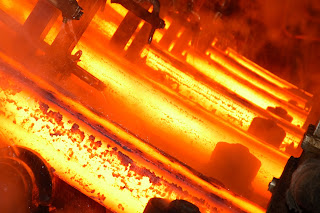 |
| Many industrial processes utilize heat as an energy input |
- Steam
- Fuel
- Electric
- Hybrid
The technologies rely upon conduction, convection, or radiative heat transfer mechanisms, soley or in combination, to deliver heat to a substance. In practice, lower temperature processes tend to use conduction or convection. Operations employing very high temperature rely primarily on radiative heat transfer. Let's look at each of the four heating methods.
STEAM
Steam based heating systems introduce steam to the process either directly by injection, or indirectly through a heat transfer device. Large quantities of latent heat from steam can be transferred efficiently at a constant temperature, useful for many process heating applications. Steam based systems are predominantly for applications requiring a heat source at or below about 400°F and when low-cost fuel or byproducts for use in generating the steam are accessible. Cogeneration systems (the generation of electric power and useful waste heat in a single process) often use steam as the means to produce electric power and provide heat for additional uses. While steam serves as the medium by which heat energy is moved and delivered to a process or other usage, the actual energy source for the boiler that produces the steam can be one of several fuels, or even electricity.
FUEL
Fuel based process heating systems, through combustion of solid, liquid, or gaseous fuels, produce heat that can be transferred directly or indirectly to a process. Hot combustion gases are either placed in direct contact with the material (direct heating via convection) or routed through tubes or panels that deliver radiant heat and keep combustion gases separate from the material (indirect heating). Examples of fuel-based process heating equipment include furnaces, ovens, red heaters, kilns, melters, and high-temperature generators. The boilers producing steam that was described in the previous section are also an example of a fuel based process heating application.ELECTRIC
Electric process heating systems also transform materials through direct and indirect means. Electric current can be applied directly to suitable materials, with the electrical resistance of the target material causing it to heat as current flows. Alternatively, high-frequency energy can be inductively coupled to some materials, resulting in indirect heating. Electric based process heating systems are used for heating, drying, curing, melting, and forming. Examples of electrically based process heating technologies include electric arc furnace technology, infrared radiation, induction heating, radio frequency drying, laser heating, and microwave processing.
HYBRID
Hybrid process heating systems utilize a combination of process heating technologies based on different energy sources or heating principles, with a design goal of optimizing energy performance and overall thermal efficiency. For example, a hybrid steam boiler may combine a fuel based boiler with an electric boiler to take advantage of access to low off-peak electricity cost. In an example of a hybrid drying system, electromagnetic energy (e.g., microwave or radio frequency) may be combined with convective hot air to accelerate drying processes; selectively targeting moisture with the penetrating electromagnetic energy can improve the speed, efficiency, and product quality as compared to a drying process based solely on convection, which can be rate limited by the thermal conductivity of the material. Optimizing the heat transfer mechanisms in hybrid systems offers a significant opportunity to reduce energy consumption, increase speed and throughput, and improve product quality.
Many heating applications, depending on scale, available energy source, and other factors may be served using one or more of the means described here. Determining the best heating method and implementation is a key element to a successful project. Alliance Technical Sales specializes in electric heating applications and facets of the industrial production of steam. Share your process and project challenges with them and combine your facilities and process knowledge and experience with their product application expertise to develop effective solutions.
Many heating applications, depending on scale, available energy source, and other factors may be served using one or more of the means described here. Determining the best heating method and implementation is a key element to a successful project. Alliance Technical Sales specializes in electric heating applications and facets of the industrial production of steam. Share your process and project challenges with them and combine your facilities and process knowledge and experience with their product application expertise to develop effective solutions.





